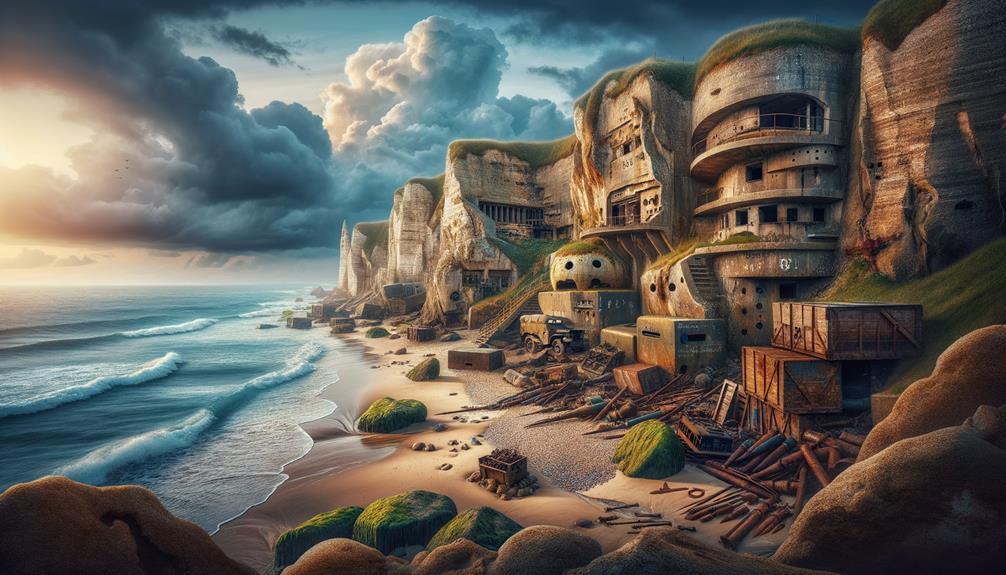Nearly 75 years after the D-Day landings, the Caen Memorial Museum draws over 400,000 visitors each year, all looking to understand that crucial moment in history better. Walking through its halls, I felt the weight of the stories told in the exhibits, from the detailed models of Mulberry Harbour to the haunting footage in the Arromanches 360 Circular Cinema. Standing before the Peace Memorial and the Wall of Names, the enormity of the sacrifices made hit me deeply. But there's one site that made an unforgettable impression on me, which I'll share next.
Caen Memorial Museum
Located in the British Sword Beach area, the Caen Memorial Museum offers a deeply moving exploration of World War II and the Cold War through its vast displays and informative guided tours. As I walked through the museum, I was struck by a profound sense of respect and admiration. The exhibits thoroughly cover the D-Day landings, highlighting the immense scale and emotional impact of that crucial point in history.
One of the most moving parts of the visit was following the path of the D-Day landings. As I wandered through the displays, I could almost hear the echoes of the past—soldiers' footsteps, the roar of engines, and the distant rumble of artillery. The museum's authenticity is enhanced by the preserved Bunker of General Richter, providing a tangible link to the events on Sword Beach.
The Peace Memorial and Wall of Names are powerful reminders of the human cost of war. Each name etched into the wall represents a story of bravery and sacrifice. The guided tours and educational programs at the Caen Memorial Museum make it more than just a historical site; it's a journey through time that leaves a lasting impression on every visitor.
Arromanches-les-Bains

Standing on the beach in Arromanches-les-Bains, I was struck by the remnants of the Mulberry Harbour, a testament to the ingenuity of the D-Day planners. The Arromanches 360 Circular Cinema brought the harbor's construction to life with its immersive sights and sounds. Inside the D-Day Museum, exhibits vividly depicted the harbor's crucial role in the invasion's success.
Mulberry Harbour Remnants
Arromanches-les-Bains offers a fascinating peek into history with its remnants of the Mulberry Harbour, showcasing the incredible engineering that was crucial for the D-Day landings. Standing on the beach, I see the skeletal remains of the artificial harbor emerging from the sea like silent guardians of the past. These concrete structures, known as 'Phoenix caissons,' were towed across the English Channel and assembled to create a temporary port, allowing for the rapid offloading of troops, vehicles, and supplies needed for the Allied landings.
The D-Day Museum in Arromanches provides an in-depth look at the planning and execution of this monumental effort. Inside, I find exhibits that bring the scale and audacity of the Mulberry Harbours' construction to life. Models, photographs, and personal accounts highlight the challenging yet heroic efforts of the engineers and soldiers who made it all possible.
Walking along the shore, I feel a deep respect for the bravery and ingenuity that turned this small town into a vital gateway for freedom. The remnants of the Mulberry Harbour stand as a tribute to human resilience and the steadfast spirit of the Allied forces.
360 Circular Cinema Highlights
Standing on the shore, gazing at the remnants of the Mulberry Harbour, I soon find myself drawn to the nearby Circular Cinema in Arromanches-les-Bains. This cinema offers a 360-degree viewing experience that vividly brings the epic tales of the D-Day landings to life. Perched on a hill, the Circular Cinema provides stunning panoramic views of the artificial harbor, a testament to human ingenuity and resilience.
As I step inside, I'm immediately surrounded by a whirlwind of sights and sounds. The cinema's multimedia exhibits envelop me, creating an experience that feels both intimate and grand. Through immersive storytelling, the cinema showcases the monumental effort behind constructing the Mulberry Harbours. These floating harbors were crucial in supporting the Allied invasion, allowing for the swift unloading of troops and supplies.
The 360-degree film transports me back to 1944, making me feel the urgency and determination that defined the D-Day landings. It's more than just a visual feast; it's a deeply moving narrative that honors the bravery and sacrifice of those involved. The Circular Cinema in Arromanches-les-Bains isn't just an attraction—it's a vivid portal into history, offering a profound connection to the past.
D-Day Museum Exhibits
Walking into the D-Day Museum, I'm immediately struck by the meticulous displays that chronicle the incredible engineering and strategic vision behind the Mulberry Harbours. Set in the picturesque town of Arromanches-les-Bains, this museum offers more than just historical artifacts; it provides a visceral connection to the monumental efforts that shaped the course of World War II.
The exhibits showcase human ingenuity brilliantly. Through detailed models and interactive displays, I can see how the Allies constructed these artificial harbors to facilitate the rapid offloading of troops, vehicles, and supplies. The museum brings to life the sheer scale and complexity of the operation, from the initial planning stages to the relentless execution under fire.
One of the most engaging moments is standing before the panoramic windows, which offer stunning views of the remnants of the Mulberry Harbours still visible in the waters of Arromanches-les-Bains. It's a humbling experience to witness this engineering marvel, a silent guardian of freedom.
As I wander through the exhibits, I can't help but feel a deep appreciation for the bravery and innovation that these harbors symbolize. The D-Day Museum ensures that the legacy of the Mulberry Harbours and their pivotal role in the invasion endures for generations to come.
Longues-sur-Mer Battery

Standing at the Longues-sur-Mer Battery, I felt a deep connection to history, surrounded by the original artillery that once defended this coastline. The massive casemates still house the same guns used during the D-Day invasion, offering a tangible link to the past. As I looked out over the panoramic views of the English Channel, I couldn't help but imagine the intense battles that took place here.
Historical Significance
Perched on the cliffs above the English Channel, the Longues-sur-Mer Battery stands as a somber reminder of the German defensive strategies during World War II. Walking through this well-preserved artillery battery, the weight of its historical significance is palpable. This site played a crucial role in the German efforts to repel the Allied D-Day invasion.
As I move among the four massive casemates, I can almost feel the tension of June 6, 1944, when these guns roared to life against the approaching Allied naval fleets. The Germans had chosen this spot wisely; it offers a sweeping view of the coast, making it a significant challenge for the invading forces. The battery's importance during the D-Day invasion is almost tangible, with echoes of the past seemingly carried on the sea breeze.
Standing here, I gain a deeper understanding of the complexities and stakes involved in the battle for freedom. The Longues-sur-Mer Battery serves not only as a historical site but also as a tribute to the resilience and bravery of those who fought in these pivotal moments.
Original Artillery Display
One of the most striking aspects of the Longues-sur-Mer Battery is its original German artillery guns, still positioned in their casemates as if ready for action. Standing there, it's easy to imagine the tension and anticipation of D-Day. Each of the four well-preserved casemates offers a unique look into the coastal defenses that once guarded the English Channel.
Walking around the site, the scale of these German artillery guns is impressive. They highlight the engineering skills of the time and the strategic importance of this location. The panoramic views of the Normandy coast are stunning, but it's impossible to forget the grim history these landscapes have witnessed.
Information plaques around the site provide context, explaining the role of the Longues-sur-Mer Battery during the D-Day invasion. It's a sobering experience, standing where soldiers once stood, their futures uncertain. This site isn't just a collection of old weapons; it's a powerful reminder of the resilience and bravery that defined that crucial moment in history.
Normandy American Cemetery
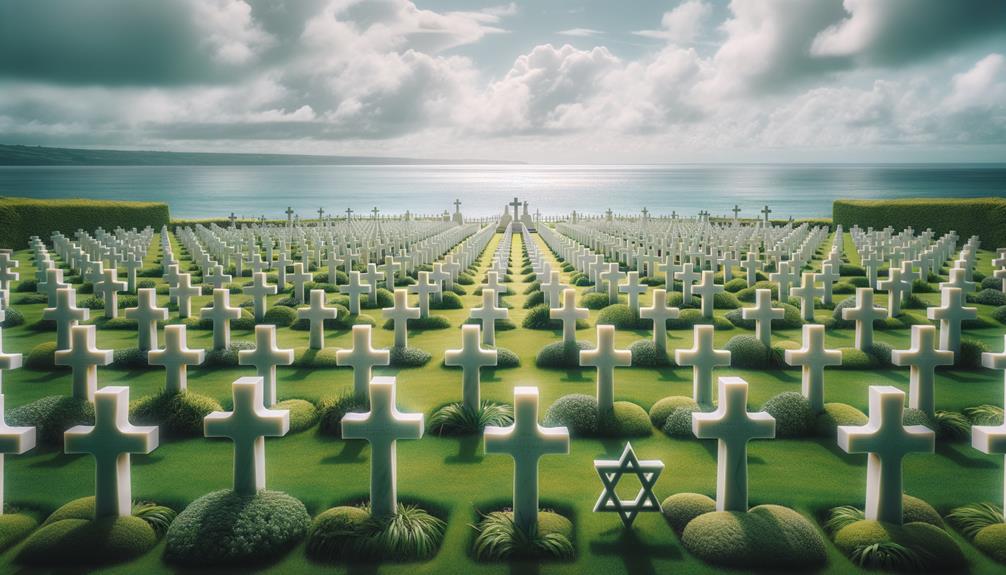
Walking through the Normandy American Cemetery in Colleville-sur-Mer, I was struck by the rows of white crosses and Stars of David that seemed to stretch on forever. This solemn place is the final resting ground for over 9,300 American soldiers who fought bravely during World War II. More than just a burial site, the cemetery stands as a poignant reminder of the sacrifices made on D-Day.
The peaceful atmosphere is broken only by the sound of the wind rustling through the trees, almost as if whispering the stories of courage and loss. Particularly moving are:
- The Memorial with its reflecting pool
- Guided tours that offer historical context
- Educational programs that detail the human cost of war
- The endless rows of graves symbolizing the bravery of the Allied forces
Standing by the reflecting pool at the Memorial, I felt a deep connection to the past. Each grave marker tells a story of a life cut short, a testament to the price of freedom. Visiting the Normandy American Cemetery isn't just about remembrance; it's a tribute to the enduring spirit of those who fought for liberty on D-Day.
Omaha Beach
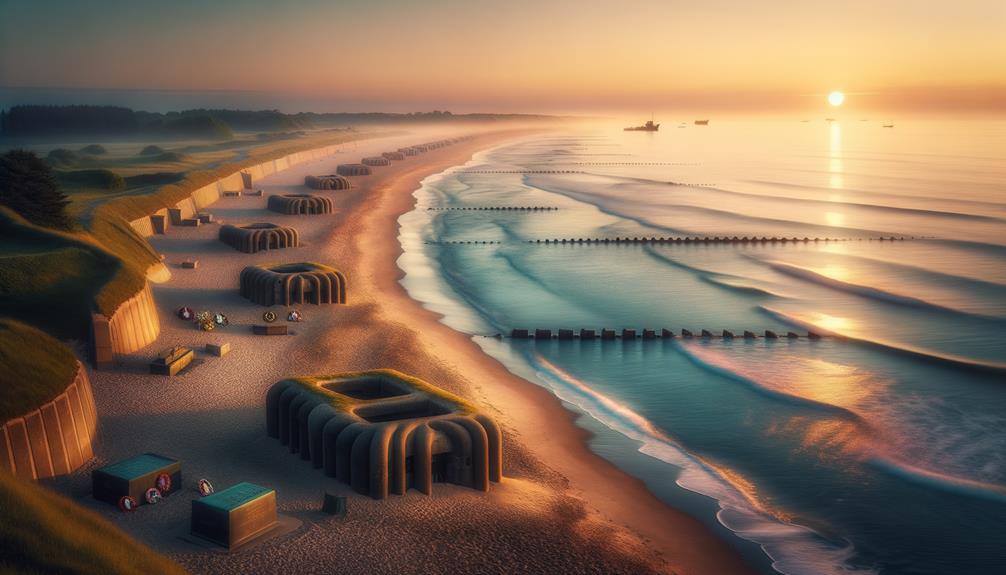
Standing on the sands of Omaha Beach, I felt the immense weight of history. It's the very spot where countless soldiers faced unimaginable challenges and showed unmatched bravery. This part of Normandy's coastline, known as 'Bloody Omaha,' saw two-thirds of the US seaborne effort during the D-Day assault.
The landscape is striking: four miles of open beach bordered by steep cliffs, creating a dramatic and somber scene. As I walked along, it was as if I could hear the echoes of battle—the roar of the waves mingling with distant memories of gunfire and determination.
Monuments and memorials dot the beach, honoring the courage and sacrifice of the Allied forces. Each plaque and statue tells a story of heroism and resilience, encouraging visitors to pause and reflect on the events of World War II.
Omaha Beach is a powerful place for remembrance. It's where freedom was fiercely fought for and won. The bravery shown here is etched into the landscape, making it a humbling experience to stand on the same sands where history was so profoundly shaped.
Pointe Du Hoc
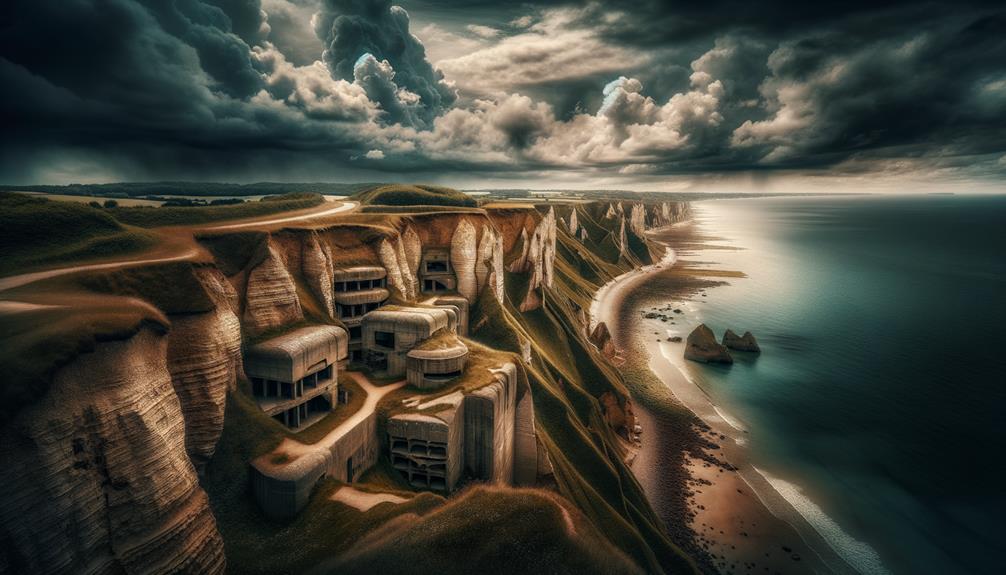
Standing atop the rugged cliffs of Pointe du Hoc, it's hard not to be amazed by the boldness of the U.S. Rangers' assault. This spot is a testament to bravery; on D-Day, the Rangers scaled these cliffs under heavy enemy fire. The landscape is dotted with craters, reminders of the fierce battle here. Each step uncovers the formidable German bunkers, now silent, that the Rangers overcame in their daring mission.
Walking through Pointe du Hoc, you can feel the weight of history. The guided tours aren't just informative; they pull you into the heart of the battle, bringing vivid images of the past to life. Looking out over the English Channel, you can almost sense the tension and determination of those young soldiers.
- Cratered terrain: Marks of the intense bombardment.
- German bunkers: Examine these fortifications.
- Panoramic views: Beautiful yet haunting.
- Historical insights: Detailed accounts from guided tours.
Pointe du Hoc is more than a battlefield; it's a story of courage and sacrifice. Here, the spirit of freedom is tangible, a powerful reminder of the cost of liberty.
La Cambe German War Cemetery
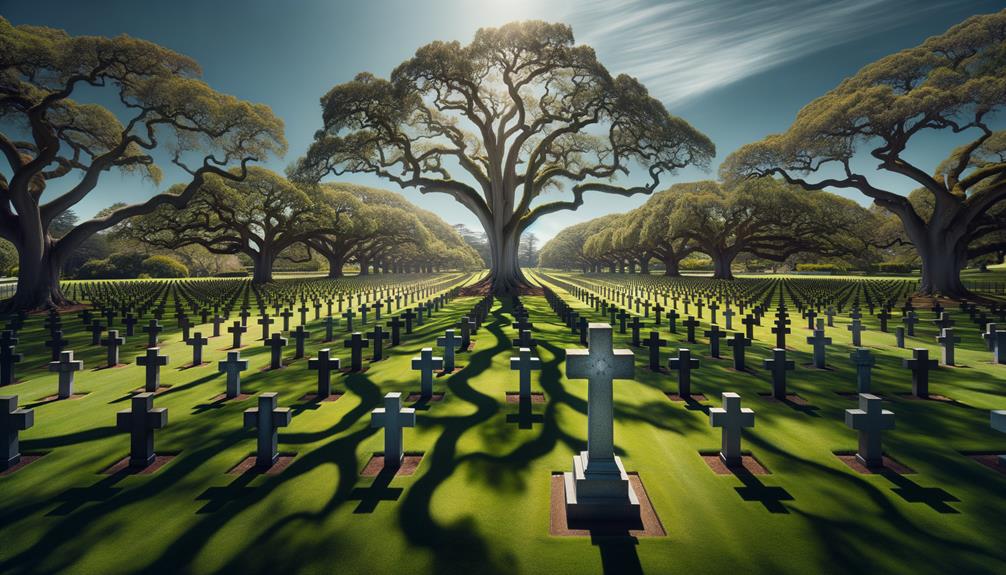
Walking through La Cambe German War Cemetery, I felt a deep sense of reflection and solemnity, surrounded by the graves of over 21,000 German soldiers who died in World War II. The atmosphere was strikingly peaceful, a stark contrast to the violent history that led to its creation. Rows of dark crosses and individual headstones stood in somber silence, each marking a life lost in the chaos of war.
The cemetery also has mass graves, their simple markers highlighting the sheer scale of loss. Unlike the more elaborate Allied cemeteries, La Cambe's simplicity struck me deeply, emphasizing the shared humanity and sacrifices on all sides of the conflict. As I walked among the graves, I couldn't help but think about the young lives cut short, the families forever changed, and the futility of war.
La Cambe German War Cemetery serves as a powerful reminder that history isn't just a collection of dates and events, but a tapestry of human experiences and sacrifices. It's a place where the past whispers to those willing to listen, urging us to remember and learn from the sacrifices of soldiers who fought in World War II.
Pegasus Bridge

Leaving the somber atmosphere of La Cambe, I arrived at Pegasus Bridge, where the bravery and strategic maneuvers of the D-Day landings still linger. This crucial crossing over the Caen Canal played a pivotal role in the success of the Allied invasion.
In the dead of night, British airborne troops launched a bold assault to seize Pegasus Bridge. This daring operation was key in stopping German reinforcements from reaching the beaches, significantly aiding the Normandy landings. Standing on the bridge, I could almost feel the tension and urgency of that historic night.
To truly grasp the importance of Pegasus Bridge, consider these points:
- Strategic Importance: Securing the bridge was critical for controlling access routes for advancing Allied forces.
- Bold Assault: The nighttime operation by British airborne troops showcased their bravery and precision.
- Modern Warfare: The mission's success underscored the effectiveness of airborne operations.
- Commemoration: The site pays tribute to the courage and sacrifice of those who fought here.
Visiting Pegasus Bridge serves as a powerful reminder of the courage and strategic brilliance that marked the Allied invasion efforts.
Frequently Asked Questions
Can You Visit D-Day Beaches Without a Tour?
Sure, you can visit the D-Day beaches on your own. I wandered around Omaha and Utah Beaches at my own pace, enjoying the freedom. Informational signs and visitor centers added depth to my trip, making it a very personal and flexible experience.
Why Is Caen Famous?
Caen is well-known for its rich history and lively culture. When I visited the Caen Memorial Museum, I was struck by how vividly it portrays major events of the 20th century, especially D-Day. The museum really makes history come to life in a memorable way.
Why Is Caen Important to D-Day?
Caen played a crucial role in the Normandy invasion. Capturing the city was like unlocking a gateway to France's liberation. The intense battles and street fights there highlighted the Allies' unwavering commitment to securing freedom and victory.
Which Normandy Landing Beach Is Best to Visit?
If you're looking for a Normandy landing beach to visit, Omaha Beach stands out. The rugged terrain and well-fortified defenses offer a powerful reminder of the past. Walking among the memorials, you can truly sense the history and courage that marked that day.

